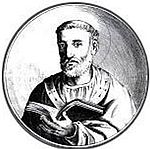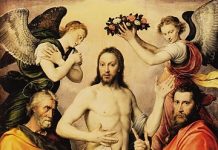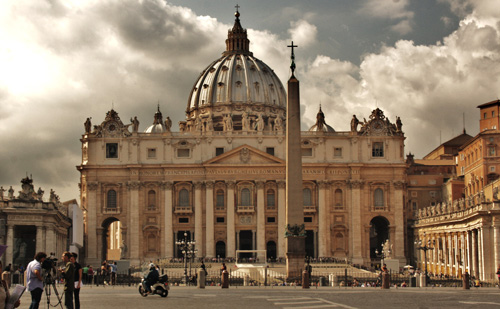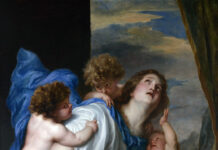On Monday 26 July 2021 I had the grace of visiting Ravenna, once the capital city of the Western Roman Empire, from 402 till 476 when the empire finally collapsed. This city, which also served as the capital of the Ostrogothic Kingdom up to the time when it was re-conquered in 540 by the Byzantine Empire, had a great holy bishop whose feast we celebrate today, July 30: St Peter Chysologus.
Church’s history tells us that this fifth-century Italian bishop is generally known for his brave witness to Christ’s full humanity and divinity within a context wherein the Church was grappling with great doctrinal confusion. In Greek St Peter is referred to as Chrysologus, which means “golden speech.” In fact, when one goes deeper into his homilies one can never miss his concise and theologically rich reflections he marvelously gave during his episcopal ministry as Bishop of Ravenna. Having seen his great God-given charism the Church did not hesitate in naming him as one of her Doctors in 1729, with the distinguished title the “Doctor of Homilies”.
St Peter was born in the Italian town of Imola in either the late fourth or early fifth century, although sources vary as to whether this took place around 380 or as late as 406. After finishing his theological studies, he was ordained deacon by Imola’s local bishop Cornelius, a figure whom Peter immensely admired to the point of considering him as his spiritual father. Cornelius not only ordained Peter, but mirrored to him the virtues of humility and self-denial.
The holy example of his mentor Cornelius led Peter to choose monastic life for many years. In fact, he spent much of his life in asceticism, simplicity, and prayer. His simple monastic life came to an abrupt end after the death of Archbishop John of Ravenna in 430. His life story informs us that the clergy and people of Ravenna chose a successor and requested Cornelius, still the Bishop of Imola, to journey to Rome and get papal approval for the candidate. Cornelius presented Peter, who was still a deacon, along with him on the visit to Pope Sixtus III.
Tradition says that the Pope had a vision from God on the night before the meeting, bidding him to annul Ravenna’s choice of a new archbishop. Alternatively, the Pope decided that none other than Peter was to be ordained as John’s successor. Coming to Ravenna, Peter was received warmly by the Western Roman Emperor Valentinian III, and his mother Galla Placidia. The story says that it was she who give him the title “Chrysologus,” due to his preaching skills.
Peter did not have an easy joy as Bishop of Ravenna. As soon as he started his episcopal ministry he immediately discovered pockets of paganism together with other abuses and wrong teachings of the Catholic faith. Peter worked with great zeal and pastoral care to stop the abuses as well as to evangelize non-Christians during his episcopal ministry as leader of the Church in Ravenna.
Peter had to counter against one of the most dangerous heresies of his time, namely monophysitism. This erroneous doctrine said that Christ did not possess a full human nature in conjunction with his eternal divine nature. In view of the devastating effects of such a heresy Peter worked tirelessly to curb the westward spread of this error, propagated from Constantinople by the monk Eutyches.
Furthermore, this zealous Archbishop of Ravenna improved the city’s cathedral and erected many new churches. Towards the conclusion of his life he wrote an important letter to Eutyches, highlighting the Pope’s authority in the monophysite controversy.
St Peter Chrysologus died in 450, precisely one year before the Church’s official condemnation of monophysitism at the Council of Chalcedon in 451. He authored around 176 surviving homilies, which contributed to his eventual proclamation as a Doctor of the Church. St Peter’s extant works present persuasive testimony to the Church’s traditional beliefs regarding Mary’s perpetual virginity, the penitential value of Lent, Christ’s Eucharistic presence, together with the primacy of St Peter and his successors in the Church.
Let us now give an example of how the Holy Spirit anointed his speech to be a staunch defender of the truth that Jesus Christ is both God and Man. In the following homily Sermo 148 (PL 52, 596-598) on the incarnation and human dignity, Chrysologus effectively highlights the significance of the incarnation, when God became a human person to promote human dignity itself. Thus, the humanity of Christ is, in fact, the first sacrament from which the other sacraments naturally come from. He preaches: A virgin conceived, bore a son, and yet remained a virgin. This is no common occurrence, but a sign; no reason here, but God’s power, for he is the cause, and not nature. It is a special event, not shared by others; it is divine, not human.
Christ’s birth is, for St Peter Chrysologus, a sacrament of piety. He says: Christ’s birth was not necessity, but an expression of omnipotence, a sacrament of piety for the redemption of men. He who made man without generation from pure clay made man again and was born from a pure body. The hand that assumed clay to make our flesh deigned to assume a body for our salvation. That the Creator is in his creature and God is in the flesh brings dignity to man without dishonor to him who made him.
When Christ became one of us this event meant that our human dignity is precious and honoured indeed. He asserts: Why then, man, are you so worthless in your own eyes and yet so precious to God? Why render yourself such dishonor when you are honored by him? Why do you ask how you were created and do not seek to know why you were made? Was not this entire visible universe made for your dwelling? It was for you that the light dispelled the overshadowing gloom; for your sake was the night regulated and the day measured, and for you were the heavens embellished with the varying brilliance of the sun, the moon and the stars. The earth was adorned with flowers, groves and fruit; and the constant marvelous variety of lovely living things was created in the air, the fields, and the seas for you, lest sad solitude destroy the joy of God’s new creation. [Genesis 1].
In his episcopal magisterium Bishop Chrysologus emphasized that the human person is the image and legate of God the Creator. He affirms: And the Creator still works to devise things that can add to your glory. He has made you in his image that you might in your person make the invisible Creator present on earth; he has made you his legate, so that the vast empire of the world might have the Lord’s representative. Then in his mercy God assumed what he made in you; he wanted now to be truly manifest in man, just as he had wished to be revealed in man as in an image. Now he would be in reality what he had submitted to be in symbol.
In his powerful Sermon 148 St Peter drives home the point that the incarnation really restores our nature as well as dignity as human beings. He says: And so Christ is born that by his birth he might restore our nature. He became a child, was fed, and grew that he might inaugurate the one perfect age to remain for ever as he had created it. He supports man that man might no longer fall. And the creature he had formed of earth he now makes heavenly; and what he had endowed with a human soul he now vivifies to become a heavenly spirit. In this way he fully raised man to God, and left in him neither sin, nor death, nor travail, nor pain, nor anything earthly, with the grace of our Lord Christ Jesus, who lives and reigns with the Father in the unity of the Holy Spirit, now and for ever, for all the ages of eternity. Amen.
O God, who made the Bishop Saint Peter Chrysologus an outstanding preacher of your Incarnate Word, grant, through his intercession, that we may constantly ponder in our hearts the mysteries of your salvation and faithfully express them in what we do. Through our Lord. Amen.












